Episode #4: How Content is used to Generate Leads in the Fintech Space
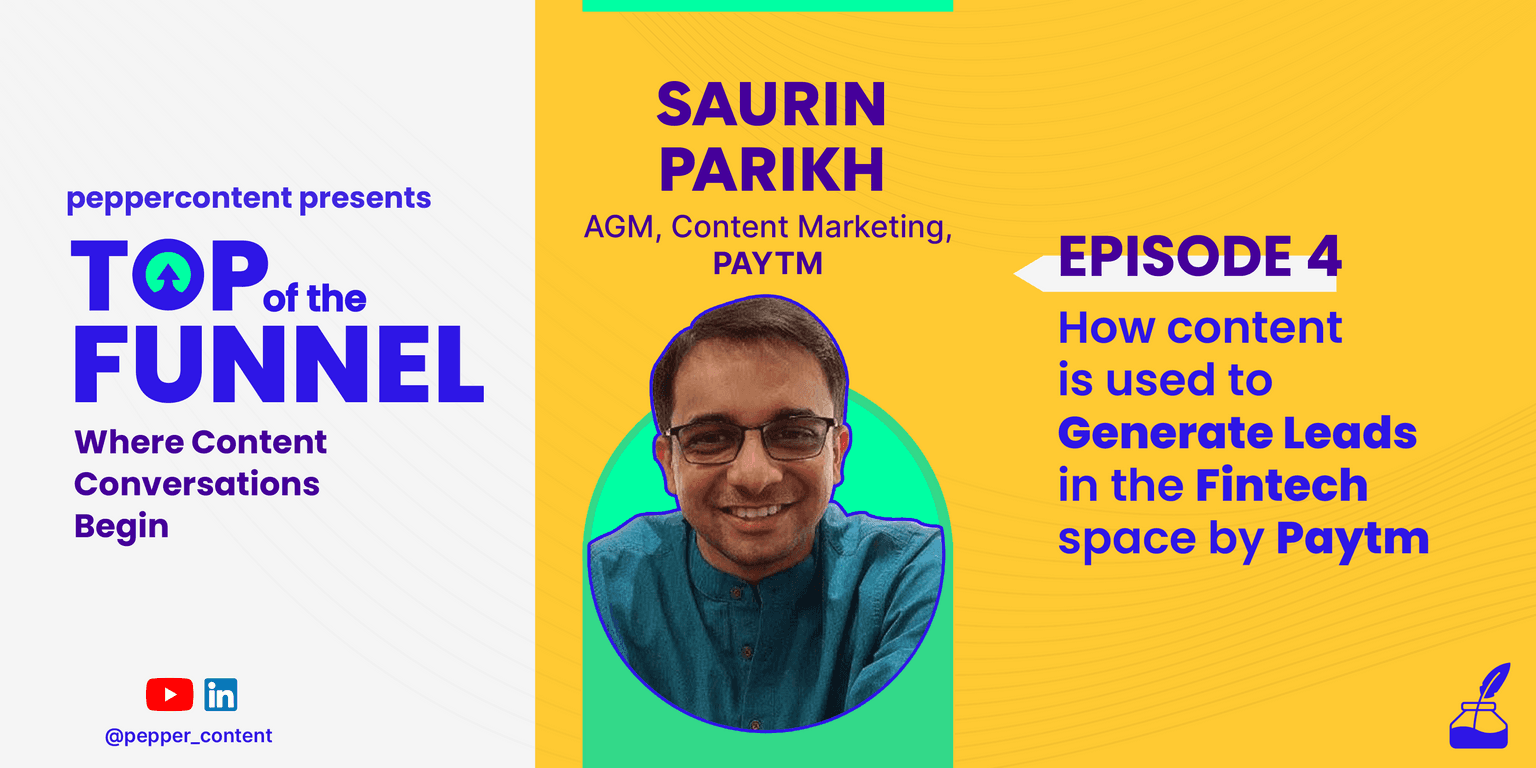
Content marketing is centered on creation and distribution across all industries. Saurin Parikh, the AGM of Content Marketing at Paytm, and Natasha Puri, Content Marketing Lead at Pepper Content unpack the nuances of content marketing in the fintech space. The end goal of every content marketing strategy is to generate leads. Saurin outlines how content is used to generate leads in the fintech space. Value-based research and keeping up with the happenings of the world are two of the most integral qualities a content marketer in the fintech space must possess.
Natasha Puri: Hello everyone. Welcome to the Top of the Funnel series, where content conversations begin. I am your host, Natasha Puri, content marketing lead at Pepper Content. We invite senior marketing leaders all over the country, across all countries to talk us through the role of content in their businesses. From meeting rooms to board rooms, everyone wants to know the content plan. This is the change that we are here to capture in the Top of the Funnel series.
Today our guest is Saurin Parikh, a writer, and a journalist first, and then a content marketer. He has headed content marketing for reputed organizations like Clear Tax and Razor Pay. He is currently the assistant general manager of the content marketing team at Paytm.
This session would have a lot of insights from a content marketer in the finance space. We would also know about his transition from a journalist to a marketer in our chat today. Hello Saurin, thank you so much for joining us. Tell us a little bit about your journey so far. You have dabbled in a lot of things. What are you currently doing at Paytm?
Saurin Parikh: I started out as a copywriter way back in 2004, where I worked with an ad agency in Ahmedabad for about three years. It was then that I move into financial journalism. I combined it with value research. At that time, I had no clue about personal finance things like mutual funds, or tax, or insurance medication. But, I joined as an editor and started to learn on the job.
It was one of the best decisions that I made because that sort of kick-started my journey in finance. And since 2007, till now, for the past 14 to 15 years, I’ve been in the finance-tech industry entirely, from journalism to startups. At Paytm, I am leading the B2B content marketing efforts. This is how my journey has been so far, from copywriting to finance. As you mentioned earlier, I still think of myself as a writer more than a content marketer. Writing is my first love. So, this has been my career so far.
Natasha Puri: I studied journalism too, but never became a journalist. And then I moved on to multiple things like an editor at a publishing house. I eventually landed up as a content marketer. So that’s why I think it’s quite interesting that you made that transition. Can you talk a bit more about how being a journalist has impacted your skills as a content marketer? How did it get you here?
Saurin Parikh: I think the publicity and eyeballs, articles published in value research in The Economic Times helped me transition from being a journalist to a marketer in the fintech space. I was able to build an audience on online platforms and social media profiles like LinkedIn and Twitter primarily.
This helped me transition into content marketing when I joined Clear Post in 2016. At that time, I don’t think there was something called content marketing. Content writing was pretty much in the initial stages where, brands were trying to understand the importance of ranking and SEO, and using content as a means to create awareness for the brand to get leads.
Being in journalism, I knew the content that you’re putting out has to be of top quality. When you create content for brands or video properties, you are pretty much putting it there for free. But, as a journalist, you’re writing or reporting, writing stories for people who have subscribed to you, either the physical paper or the online versions. They are paying for what you’re writing.
So whatever stories you’re creating, it has to be something that they don’t get anywhere else. This is a kind of approach that I try to bring into content marketing as well. My team and I want to ensure that these are data-driven stories. Every argument that we make is sort of guided through data or, our own experiences, or the experiences of our peers and seniors.
All these aspects of journalism and the old mindset of creating stories out of whatever idea that you have blended well into content marketing. The whole element of storytelling using data, ensuring that every piece of content that you put out is useful to the reader and, they find it important enough to, not just consume themselves but share it across their networks applies here too. The experience of being a journalist upgraded with content marketing.

Natasha Puri: Those are some really interesting points that you made. Can you summarize three things that being a journalist you can use as an advantage when it comes to content marketing?
Saurin Parikh: I think the most important thing to do is to use data as much as you can to make better arguments. You have to build a story surrounding that content, ensuring that the content that you are creating would be an end piece for that particular topic. So your reader should not be required to go anywhere else to find out something more. You can go two or three levels deeper into what are you creating, writing so that, whatever information you put out answers any question that comes into your reader’s mind. You will have depth in your articles by using data and stories.
Natasha Puri: These are really great inputs. Let’s fast forward a bit and talk about what a day looks like in the life of assistant general managers for content marketing at Paytm. What does your day look like? How is your work structured?
Saurin Parikh: Sure. We plan our work in terms of quarters. We plan for an entire quarter and break it down into months and fortnightly sprints. We plan for a longer calendar. And, everybody has their own task for that particular sprint that they work on. Personally, I also focus on a lot of writing myself. Being the senior person, I need to juggle the role of an editor or the strategist for the products that we have. I also spend a lot of time writing myself because I believe that if I stopped being a good writer, I would stop being a good editor.
Apart from that, the work involves interacting with the product team to understand the product pipelines, delivering the articles, or the content that you created and help them understand how we can get better, give them inputs on what they can add or whatnot, what kind of elements they can remove from the individual pieces, and so on.
We also interact closely with the rest of the marketing team because the content works across functions in marketing, whether it be the growth marketing team or the performance team or, brand marketing teams, or social teams. I am pretty much involved in all kinds of activities that happen for the B2B side of the team and using PR for that matter. I try to use content wherever it’s required, and not try to stitch all of it together to have a coherent storyline or a pipeline for the brand.
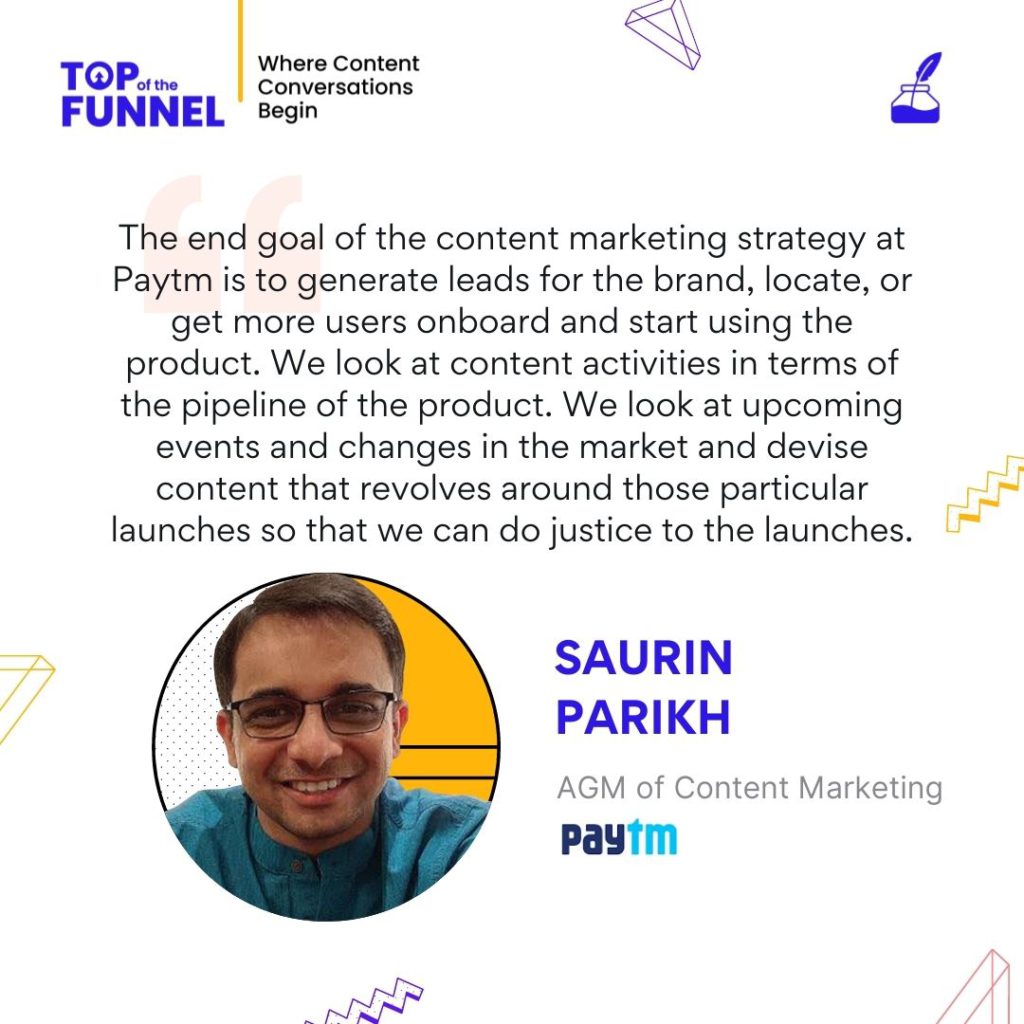
Natasha Puri: What does a content marketing strategy that you have designed look like at Paytm?
Saurin Parikh: The ending worth of content marketing is to generate leads for the brand, locate, or get more users onboard and start using the product. We look at content activities in terms of the pipeline of the product. Then, we speak with the team and understand the features we are rolling out, or revise the new launches that are happening in the coming quarter. Then, it is time to devise content that revolves around those particular launches so that, we can do justice to the launches. Of course, the product features that they roll out have to reach a wider audience, and marketing plays a big role in that. So that’s one part of the strategy.
Apart from that, we want to, make sure that our content is easily discoverable. So we try to look at keywords with the SEO team and try to devise content for the same at that time. I think of SEO as reactive and proactive. The reactive SEO is where you look at the high-volume keywords and try to churn out content to rank for those keywords that are already there. But proactive SEO is where you will not try to stay on top of the trends. You will try to figure out what is going to rank next, and devise content to have the first-mover advantage for that.
We follow the news. We follow whatever RBI is doing in the FinTech space. We follow what NPS is doing in the payment space, and see what kind of changes they are bringing in, and what kind of content can we work around that so that we can answer questions before they come to our readers’ or users’ minds.
Natasha Puri: I’d love to know a bit about the team structure as well.
Saurin Parikh: In a newspaper or in the media house, every reporter has a specific beat that they look after. Similarly, in the content marketing team at Paytm right now, or previously in the different organizations, every writer was assigned a specific product.
There are some people who are working on a payment gateway, some working on the payouts product, some working on the Paytm ads products, and so on. This helps them to stay in tune with the product, as well as the industry that the product is based on. They can speak with the product marketers, product managers, and figure out what kind of content is required to drive higher adoption for the product.
The writing team or the creative team itself is structured in that way. Every person is assigned to a separate product. Apart from that, we work closely with the design team because a lot of content requires some design help. There is a design team involved with us along with the SEO team. We work closely with them, not only to understand what kind of keywords we want to rank for, but also to understand how our ranking is changing on a day to day, or week to week basis.
If you are dropping in ranking for certain keywords, you can optimize the existing content to rank for those keywords again, or if you are missing out on some opportunities, you can spot them, and create content to tap into those opportunities. This is how pretty much every other team is structured. Apart from that, we also work closely with different aspects of marketing, like the growth team, email marketing team, brand team, and performance team.
Natasha Puri: There is a perception that B2B content can be very boring. They don’t see it as very interesting. It is a serious sort of industry. So, how do you make B2B content in the FinTech space interesting and appealing? Feel free to give us a few examples of a piece of content that actually generated that kind of interest from your target audience.
Saurin Parikh: Finance is something which, people find boring and something that’s easy to procrastinate. It sort of prompts them to think they will do it tomorrow. There is very rarely some kind of urgency from the user to do something with their finances, like income taxes. We have the whole year to do our tax savings, but we do it in March. Again, in the B2B FinTech space, there’s a bit more urgency because somebody has a payment gateway. The business needs to get operational. So it’s not something that they procrastinate on, but it’s easy to look over and delegate the responsibility to somebody else. Being a B2B brand, we can’t be as flippant as at a B2C brand.
We can’t rely on users as Dunzo or Swiggy does, but B2B marketing does not have to bore. It is eventually still speaking to a human within a business. So, there is room for some kind of playing around, some experimentation that you can do.
And, I think the best way to not put out boring content is to use data and stories. Everybody likes a good story. So, there could be customer stories. It could be stories about the brand itself. There could be stories about how a particular event unfolded or, data that everybody likes.
When we generate white papers, we bring data into the element of the content. Everybody likes to look at data, to see how the UPI doing or how people are using credit cards, and so on. We can use data and stories to make B2B content less boring. But yeah, I can imagine how the audience would sometimes find it boring.
Natasha Puri: Now that you’ve touched upon the pandemic and its impact on content overall, I would love to know your view on content, as some people think that this is a bubble that will burst. There is a lot of content now. Eventually, people would not want it. And of course, some people are a lot more optimistic that this is now an acceptable sort of way of life. Content is getting its due importance. So, what are your thoughts on it? What is that future post-pandemic world kind of going to look like in terms of content marketing?
Saurin Parikh: In modern marketing, content has gotten its due in the past. There is no marketing without content. If you are going to run ads, you need copies. If you want to run email campaigns, you need content for the e-mails. If you’re going to have blogs, you need a content plan and articles. But if you’re going to use social media or want to do something on the brand front, you need to create a video. Again, you need content for the script. So the content is there. Essentially, no marketing is without content. So, the content will continue to be one of the pillars of marketing going forward. I think maybe the bubble will burst. It will not be enough to just create content or sub-par content. There will be more focus on creating quality content or content, which is actually useful to the users.
I have sort of, created a theory of my own, like every content should have a USP. Their USP should be useful. It should be shareable. It should be productive. The piece of content should be so useful that the user would be drawn with a specific intent to understand or to learn something.
If it is useful, it serves a purpose. And, if it serves the purpose, it becomes shareable for you. If you find something useful, you’ll share it on your Twitter or your LinkedIn. You will also pass it on to your friends on Whatsapp. Sharing is important for the consumer and the brand. The content has to be productive because it has to fulfill the function of creating awareness or, an image for the brand, which in turn would increase the reach of the brand. As long as you are productive in your USP, you will be outside that bubble, which may or may not burst.
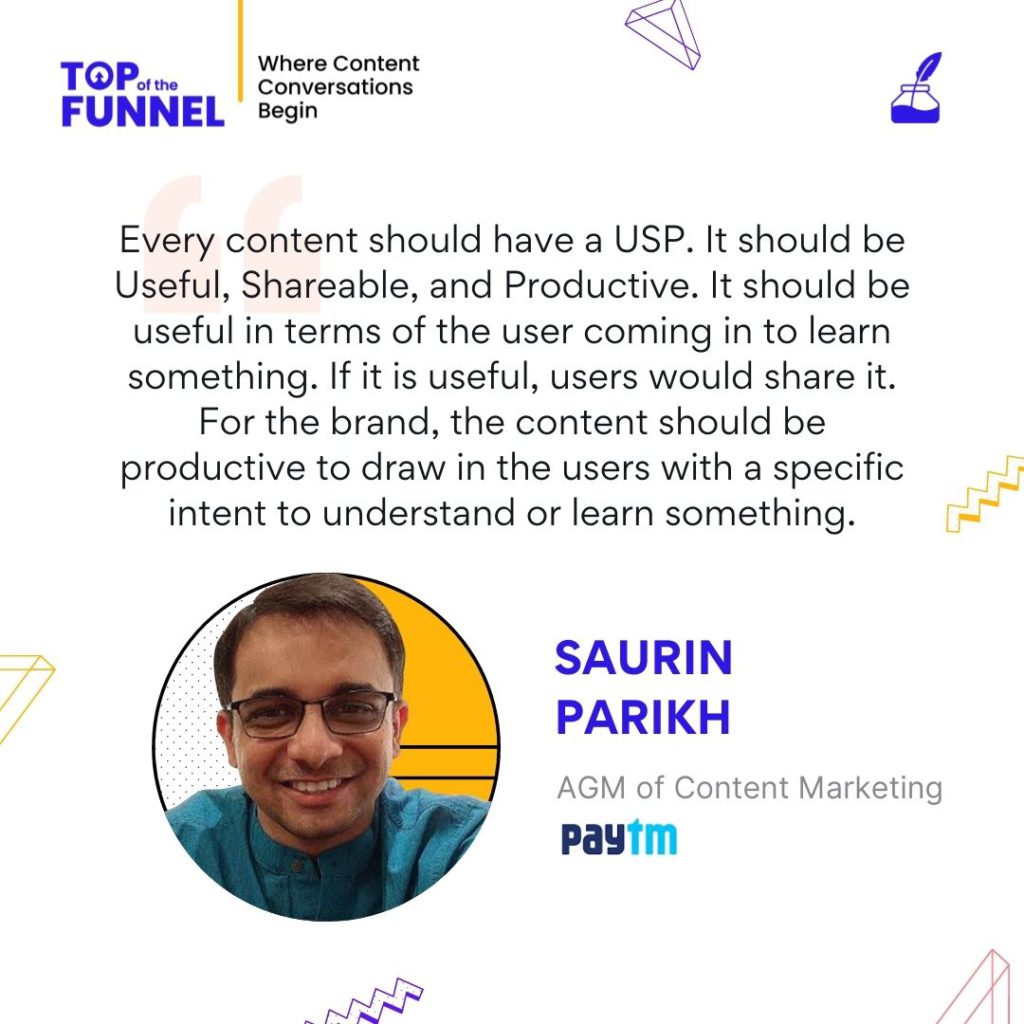
Natasha Puri: Would you talk about some campaigns that you felt were successful? How do you define those success metrics? When it comes to content success, defining ROI is still a big challenge and it would be great if you can break that down.
Saurin Parikh: Being in the FinTech space, we have always walked across value search or clear tax, as the budget in the economic space.
The budget is the pivotal event of the year. It gets a lot of eyeballs, a lot of attention from the media, from the brand itself, because there is always something that affects somebody or the industry. We create content around the budget. With the help of the team that I’ve worked with, these plans always got a lot of ROI for us.
Sometimes we measure success in terms of the kind of traffic we got for our branding, articles, or in terms of the kind of PR attention we want out of the media, or the budget, or in terms of the stories we have created, or in terms of the sign-ups that we got. So, Budget has always been a sort of an event that we look forward to because it gives a good indication of where the country is heading, what you can expect from the coming year, what will come and go. I personally like to watch the budget very closely myself.
Apart from that, it also gives a content creator or content marketer the opportunity to speak to their audience. So, if I am an e-commerce merchant and wish to understand the impact of the budget for me, I might not have the kind of knowledge to figure it out myself. So, as a content creator, you can step in and take out the budget for different industries or different sectors. It is something that has always been very useful in our efforts. Usually, we see that the budget comes in February and we see a spike in traffic, or signups because of the budget activities.
Natasha Puri: How much of the distribution and promotion of the content do you plan for ahead? Is planning the content a part of your strategy? Or, does that come later?
Saurin Parikh: No, distribution plays an equally important part as creation. The brands, leading in content marketing are focused on distribution because content creation has become easy, or people know how to do a fairly good job at it. Everybody is creating content. How do you ensure that the content that you’re creating is actually reaching your audience?
At Paytm, we put 50-50% of our efforts into creating and distributing. It could happen through social media, through newsletters to emails, or turning a piece of content into different forms. There is a very good article from a video that could be an infographic. Content is created once but could be distributed in multiple formats. It is either going to be a real winner or a deal-breaker for most brands.
Natasha Puri: This is my final question to you. What are the two things that excite you the most about being a content marketer and the two biggest challenges of being one?
Saurin Parikh: Personally, I like to write a lot, and writing has been my first love, so I am very fortunate to be able to. There is an old saying that if you do what you love, you will never work for a single day. So, we are fortunate to have a career in writing. People pay me for writing and I cannot really think of a dream job other than that. So, this is the one thing that excites me a lot about being into content marketing, because I like to write and create content.
Apart from that, it is very exciting because content plays a very important role in user acquisition. So, it is not just limited to creating content, or writing articles. We have to dig deep to make content useful for the brand. These are the two things that are very exciting from a content marketing front. In terms of challenges, I think we do not improve the funnel after it goes from the top. So, typically for us, the funnel would be user data or a consumer, who signs up and then, starts transactions using the product.
One of the challenges is to improve the funnel after the user has signed up or come on your website. So, that is channel B. We want to make a lot of efforts to get more readers to sign up and start transactions, using the product. The other challenges will be in terms of hiring. It is always a struggle to hire a good content team and I have thought a lot about it. There is no specific way or a scientific approach to hiring for content. It is still largely hit and miss.
Natasha Puri: Thanks again, Saurin for making time to do this, to have this conversation, I know that we have small stepping stones to make content marketing even more mainstream and relevant in India. So, every conversation counts. Thank you so much for doing this.
Saurin Parikh: More than welcome, Thank you!
Latest Blogs
Explore how Google’s 2025 AI search updates triggered ranking chaos. Learn actionable strategies to adapt your SEO for AI Overviews, zero-click searches, and SERP volatility. Stay ahead now.
Learn how to rank on AI search engines like ChatGPT, Perplexity, and Gemini by optimizing your content for authority, structure, and relevance. Stay ahead in AI-driven search with this strategic guide.
Explore the best healthcare SEO services for your medical practice. Improve online visibility and effectively reach more patients in need of your services.
Get your hands on the latest news!
Similar Posts
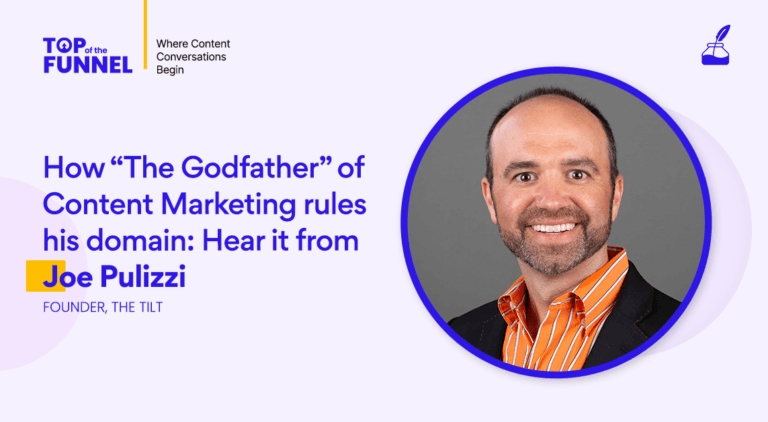
Expert Speak
18 mins read
Season 2 Episode #1 How “The Godfather” of Content Marketing Rules His Domain: Hear It From Joe Pulizzi
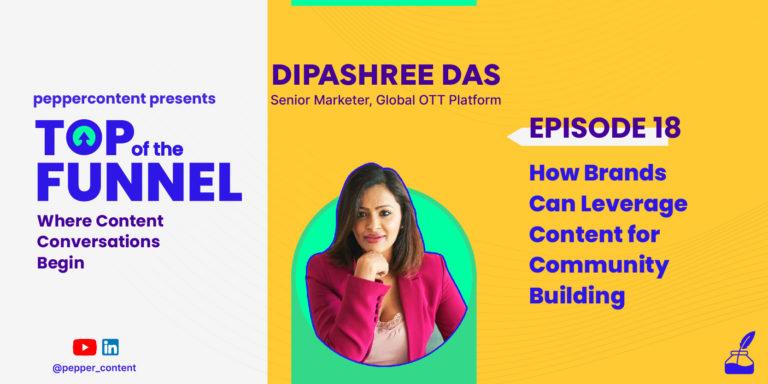
Expert Speak
16 mins read
Episode #18: How Brands Can Leverage Content for Community Building
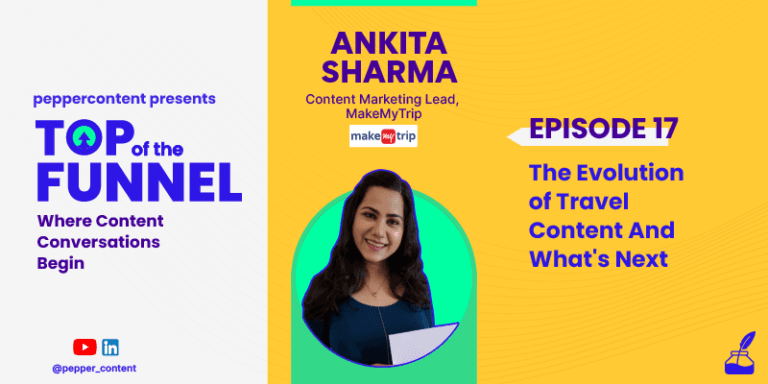
Expert Speak
11 mins read